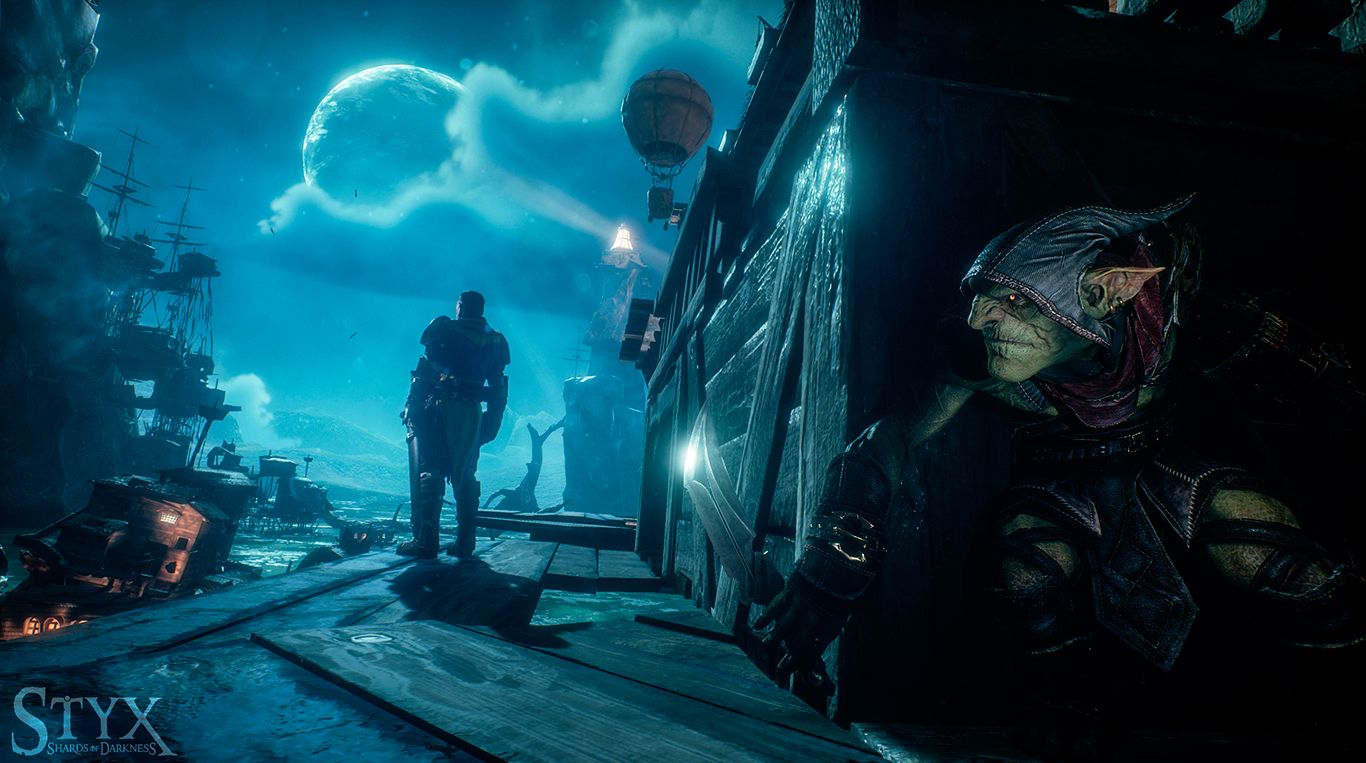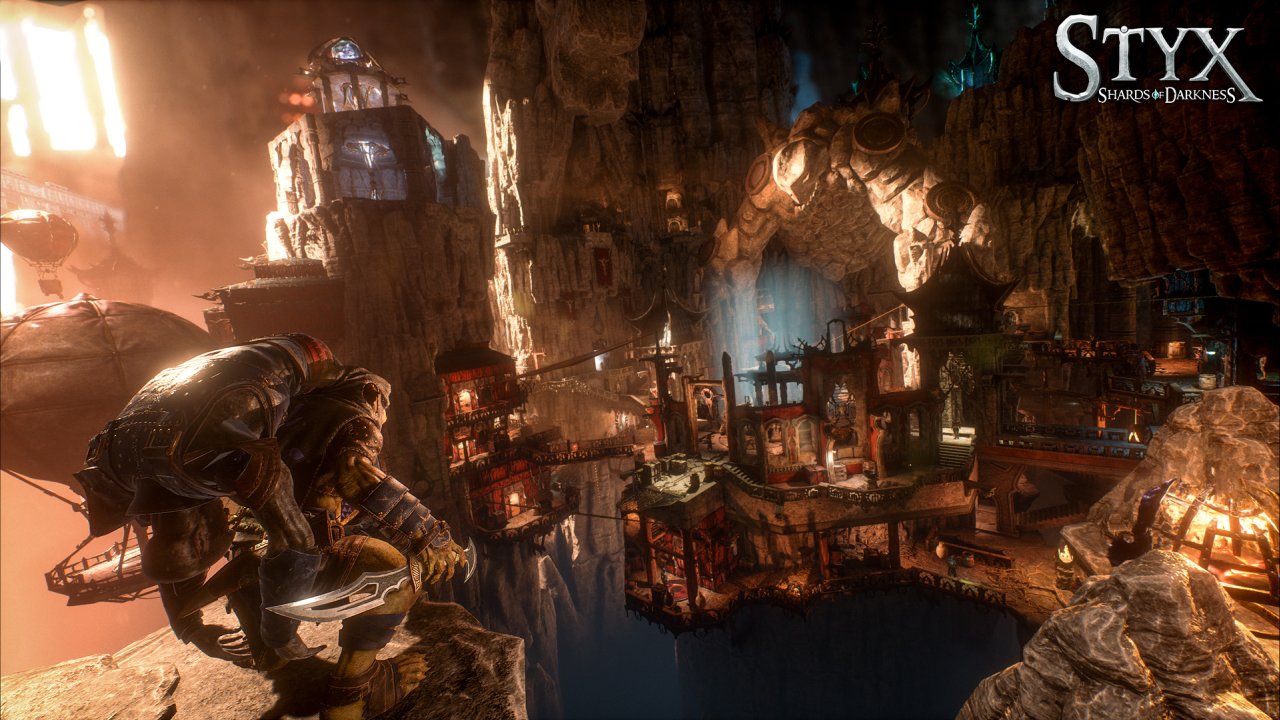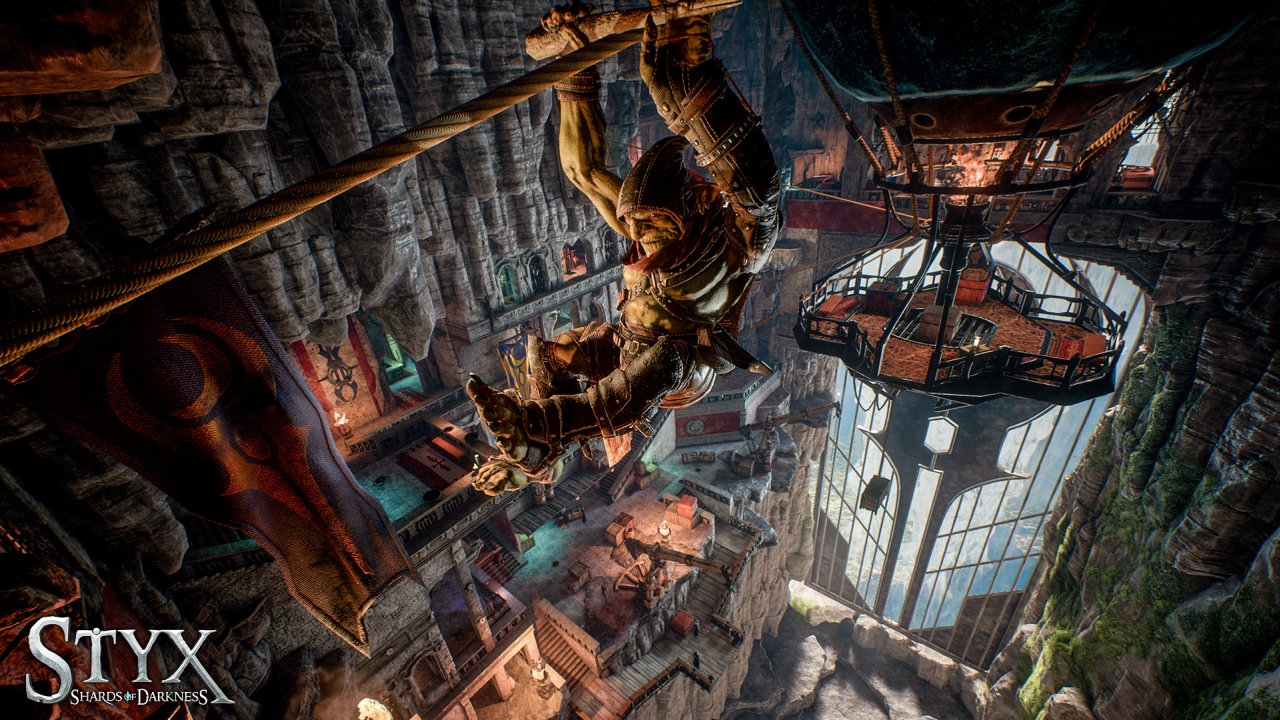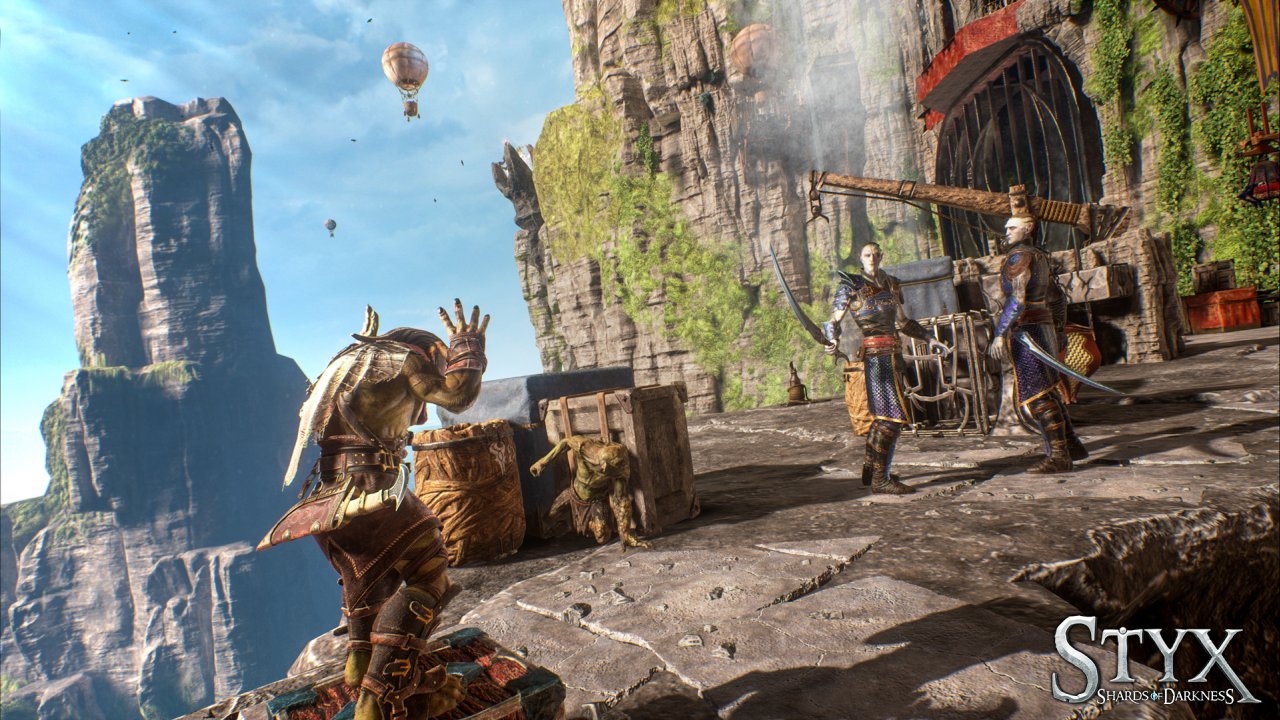Styx: Shards of Darkness Review
Way to Styx it to the man
Does anyone remember Ty the Tasmanian Tiger? It was an Australian-made early-2000s game that sailed in on the last big wave of 3D mascot platformers, the sort that was basically alright but largely forgotten by the time the next console generation rolled around. While it does occasionally get brought up Down Under—usually as part of somebody’s desperate grasping-at-straws attempts to prove we totally have a functioning games industry over here, honest—I know it mostly for a somewhat ill-advised television advert that heavily implied Ty had beaten the living daylights out of Crash Bandicoot, Sonic and Spyro, leaving them in unnerving full-body casts in a hospital ward. It was a bizarre piece of schoolboyish aggression directed at games that were—not to be too unkind to Ty here—generally accepted to be better experiences, and in hindsight it just makes what was probably a pretty okay platformer look like it was puffing up its chest far too much. Initially I chalked it up to the lingering spectre of nineties attitude and left it at that, assuming that the industry had long since moved past such petty squabbles, but colour me surprised if the trailer for Styx: Shards of Darkness didn’t cheekily snipe at Assassin’s Creed right then and there. Why belittle someone else’s work like that? Are you another Ty, a tough talker trying to hide glaring confidence issues? Or have you some transformative ace up your sleeve?

Alas, history has repeated itself, and Shards of Darkness fits the profile perfectly: a decent mid-tier game that sabotages itself by being far cockier than it has any right to be.
For those of you who don’t remember the first Styx game—don’t worry, I finished it, and it’s a miasma to me too—let’s catch up. Styx is a goblin who was transformed into the living personification of the bottom of the comments section via a magical substance called Amber, granting him the ability to speak, swear, sneak, stab and steal. The game opens with him heartily partaking in all five—I’m not sure if it establishes a reason, but I suppose everyone needs a hobby—when he’s confronted by a mortal enemy, who has a job that nobody else can do and who persuades him to cooperate with vast amounts of material goods. Alas, the seemingly simple job goes awry, and Styx becomes embroiled in a larger scheme that threatens the… well, that’s more than enough straight-faced blurb, I think. It’s a trite setup, no denying it, but the important thing is that the story beats land soundly and don’t get in the way of some good honest stealth.
At any rate, Styx is nothing if not a versatile little twerp. Much like the previous game, the stealth mechanics forego any particular focus for a loose grab-bag of toys and abilities; you can creep around out of sight, hiding in shadows, under tables and out on ledges, or if that’s too pedestrian, you can vomit up a clone to act as a decoy, turn invisible, leave acid traps underfoot and shoot people full of darts. Or, you know, you can just stab people. On a more abstract level, there’s a crafting system for your consumable equipment, and there are no less than five (!) skill trees for upgrading and acquiring new abilities, so all in all it’s more or less what you’d get if you threw a bunch of classics into a blender with every AAA trend from the past five years and turned it on; lots of perfectly good ingredients, and a relatively inoffensive whole, but a very messy, unstructured sort of design that needs to be scraped out of the beaker with a spoon.

This manifests in a few ways, but the most prominent is the layer of dust that gradually settles over your kit as the majority of it goes unused. Just about every encounter can be dealt with by just creeping around between the myriad safe hiding spots the game provides you with, and on the off-chance that it can’t, a thrown bottle or burst of invisibility is enough to take care of just about anything. A lot of your tools feel like they create as many problems as they solve; putting out a torch is likely to make a bunch of guards wander over to see why the lights are on the blink, and any remote murder solution that doesn’t take care of the body is really just asking for trouble. Hand-in-hand with this is the generally lacklustre offerings of the upgrade trees, one of which is dedicated entirely to your unnecessary ‘highlight interactive objects’ goblin-o-vision. That’s not to say there aren’t extremely useful upgrades to acquire—being able to throw and swap with your clone, in particular, lets you overcome obstacles and come away with a lingering sense of “was I even supposed to be able to do that?”—but they’re thinly dispersed, and more often than not I found myself despondently looking at my options wondering which of them could perhaps, one day, when all else is lost, be useful to have in my back pocket.
Not that I felt backed into a corner all that often, figuratively or literally. Styx 2’s level design is actually pleasantly serviceable, for the most part. You’ll be making your way through large, non-linear, vertically varied environments that give you a number of ways to approach just about any point on the map; there’s always a crawl-space, a rope, a rafter, a back-door, an open window, if you’re patient and adventurous enough. Exploration can net you crafting materials and side-objectives, and if you’re not in a rush, it’s easy to just wander wherever you please, finding and following the easiest paths wherever they may lead you.
But there’s more to level design than just providing options, and outside of that, Styx 2’s environments fall apart. There’s a persistent lack of meaningful structure to the levels that leaves them feeling samey and homogeneous. They sprawl all over the place, not like diagrams on a draughtsman’s board—all intricate and carefully planned, full of subtle symmetry and implied purpose—but like baskets of laundry upended on the floor: comfortable, but ultimately formless. A level in, say, Dishonored feels like a place that exists for the benefit of its inhabitants; a level in Styx 2 feels like a higgledy-piggledy playground for the player with an art pass over the top, full of explicitly laid-out climbing routes and hidey-holes. I’m not thinking about how the place is laid out or what the best route is; I’m just looking for the next opportunity that’ll get me one step closer to my objective marker. You can, of course, turn objective markers off, but it feels like an afterthought feature that the levels weren’t designed to accommodate, and without a map—or, in many cases, any clues at all as to where your goal is—it soon becomes clear that this is about as advisable as playing Marco Polo on the southbound freeway.

The saturation of alternative routes, while good for averting frustrating situations, also brings up an issue I seem to recall from the first Styx game: a lot of what you do doesn’t feel like it qualifies as ‘stealth’ so much as circumvention. You can totally avoid engaging with large swathes of levels by clambering unseen through the rafters or inching around on ledges, and while you could argue that this is an appropriate reward for being observant, it tends to make the experience as a whole a bit more two-dimensional than was probably intended. That’s not to say you’re totally immune to being spotted just because you’re somewhere up high, but there do tend to be an abundance of safe zones where you can just go about your business without paying attention to who’s wandering about. There’s no tension in that. Stealth games need to force you to cross spaces where your safety isn’t guaranteed, even if it’s just making you totter across a tiled floor in high heels or duck under a camera arc once in a while. Safety isn’t going to get anyone’s heart racing, and in Styx 2, safety is all too often a guarantee.
You may be surprised to hear, then, that I visited the game over screen so often that if it were a café I’d be entitled to a free mug of boiled grit by now. By which I mean, I died a lot. Not that’s a sign of a problem in itself, but so rarely did it feel like an apt punishment. By and large the NPCs aren’t the brightest bunch—I mean, it’s a stealth game; they kind of have to be on the intellectual level of Looney Tunes antagonists, or you’d never get anywhere—but what they lack in ability to join the dots, they more than make up for in sheer clobbering power. A lone guard can easily put you in the ground with just a careless swipe or thrown dagger, and when the alarm is raised, every single person in the building is likely to come crashing down on your head. It feels like the game doesn’t put much stock in the ‘chase’; in the cascading failure states that lie between hunky-dory and an early grave. Situations go all too quickly from the former to the latter, with only a small window to turn the tide. It doesn’t help that the climbing controls are a little fiddly and unreliable, so it’s all too easy to slip-up and plummet to an early grave, either from terminal impact or a half-dozen somewhat surprised watchmen. But what the heck, right? Garrett could barely clamber through a bathroom window without breaking his ankles and making enough racket to raise the dead, yet we still tolerated him somehow.
But then there’s Styx. Styx, the character, who is so far from tolerable that if you ground him up into a fine powder you could use him to disperse a riot mob. Somewhere in there you can see the legitimately great protagonist the writing was going for—a grouchy, reluctant anti-hero brimming with sarcastic snark, thumbing his nose at all the straight-faced high fantasy bollocks he gets unwillingly tangled up in—but it doesn’t really pan out because so many lines fall desperately, wince-inducingly flat. Your unlikely partner in crime is the leader of an anti-goblin security force, and do you know what the joke is with her? She’s big. Not even fat; just tall and imposing, a quality that Styx seems determined to ridicule because, I don’t know, he’s jealous or something. And the references, good lord. When was ‘pocket sand!’ a spicy new meme? Three years ago? Four? It’s not too tired for Styx, and neither are all the opportunities he takes to break the fourth wall with all the subtlety of a Luftwaffe air raid. On the ‘game over’ screen he even takes the chance to personally berate you for your incompetence, a risky writing gamble made doubly inadvisable by the inevitable repetition of lines and the likelihood that you only died because you didn’t quite grab the ledge you were intending to. Here and there Styx regularly finds excuses to drop snide remarks at other stealth franchises, and yeah, we’ve already established why pulling a Ty the Tasmanian Tiger is a bad idea, but he seems just as eager to draw attention to plot contrivances in his own adventure. Here’s a hint, you chronically unfunny hunchbacked twerp: pointing out bad writing doesn’t make it any less bad, it’s just dwelling on things I would’ve otherwise cheerfully glossed over.

In case one Styx isn’t enough, there’s always the option to add a second one. The entire game supports online drop-in co-op, letting you open the gates to friends—or strangers, if you’re the sort to routinely make bad decisions—at any point, for a spot of grouchy co-operation. It’s a nice feature to have in the box—if a little confusing to set up—but it feels more like something that was modded in after-the-fact than something that the game was ever really designed to accommodate, albeit a lot more stable than the average modded-in co-op experience. You can’t communicate or meaningfully interact with your partner, and you can no more effectively fine-tune the matchmaking service than a message in a bottle, so it’s basically only a good idea to attempt if you and your pal both bought the game and want to sneak around in a shared space. Having two pairs of hands certainly makes certain challenges a lot easier to get around—I suppose that’s the incentive to stick together instead of just playing as independent entities—but the experience as a whole tends to be surprisingly tense, since you can’t save and guards are quite literally one-hit kills. You’re reliant on your partner to revive you if you die, and it costs them half of their health to do so, so it’s probably best to make sure you have an existing amicable relationship with them anyway.
Toxic protagonist aside, Styx: Shards of Darkness really isn’t a half-bad stealth offer. The core loop’s satisfying enough, you’re rewarded for exploring, and while the game does have a bit too much of a penchant for caves and shanty towns—presumably because it’s easier to get away with the sprawling, homogeneous level design—it keeps the environments varied and regularly throws interesting curveballs into the fray. No, it doesn’t do anything exciting, it’s a bit rough in places, and many aspects of its design feel downright slipshod when held up against, say, Dishonored—which sure makes it look deluded when it starts drunkenly trash-talking—but ultimately, if you’re in the mood for crawling around in the gloom with a big knife and a bigger ego, you could do a lot worse than Styx’s latest installment.
 Comments
Comments



















